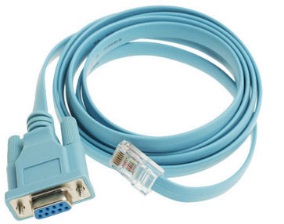First Login and System Test
When starting up your ProtectServer External 2 for the first time, follow these steps:
Access the Console
To test the system and configure the network, you must first access the ProtectServer External 2 console. There are two options:
>Direct access. Connect a keyboard and monitor (not included) to the USB (keyboard) and VGA (monitor) ports located on the unit's front panel.
>Console access. Connect the RJ45 console port to a terminal emulation device, such as a laptop or terminal server.
NOTE To access the appliance through the console port, you will need the appropriate cable. If your terminal device is equipped with a DB9 serial port, you require a cable with an RJ45 connector on one end and a DB9 serial port on the other end (see Serial cable: RJ45 to DB9). If your terminal device is equipped with an RJ45 serial port, you can use a standard Ethernet cable. Serial cables are not included.
Figure 1: Serial cable: RJ45 to DB9

If you are using a serial connection, configure your local VT100 or terminal emulator settings as follows:
|
Speed (bits per second) |
115200 |
|
Word length (data bits) |
8 |
|
Parity |
No |
|
Stop bit |
1 |
Power on and Login
Power on the ProtectServer External 2 and the (optional) monitor. A green LED on the front of the device will illuminate and the startup messages will be displayed on the monitor:
Welcome to SafeNet Protect Server External II v5.9.1 ===================================================== System is booting, this may take few minutes... SafeNet Protect Server System boot Successful
If you are using a serial connection, no startup messages are displayed.
Power-up is complete when the login prompt appears:
Protect Server External 5.9.1
PSE-II login:
You can login as admin or pseoperator to access the PSE shell (PSESH), which provides a CLI for configuring and managing the appliance. See the PSESH Command Reference Guide for command syntax.
The default passwords for the admin and pseoperator users are:
| User name | Default password |
|---|---|
| admin | password |
| pseoperator | password |
After logging in, you will be prompted to change the password for the account. Please remember your password. To change the account password at any time, login to the account and use the command user password.
The admin user can reset all account passwords to their factory defaults at any time with the PSESH command sysconf appliance factory. This command will also reset the SNMP and network settings to their factory defaults.
CAUTION! Executing sysconf appliance factory over an SSH connection may cause you to lose connection with the appliance when the IP address is reset. To avoid this, use a serial connection instead when using this command.
Run System Test
Before field testing and deployment, run the diagnostic utility. Use hsm state to display the current status:
psesh:>hsm state HSM device 0: HSM in NORMAL MODE. RESPONDING to requests. Usage Level=0% State = (0x8000, 0xffffffff) Host Interface = PSIe2 Command Result : 0 (Success)
You can also use the PSESH command status to check each of the HSM's processes. See the PSESH Command Reference Guide for command syntax.
Continue to Network Configuration
